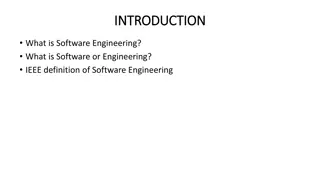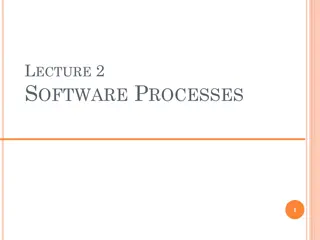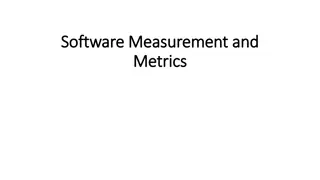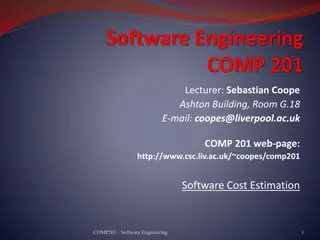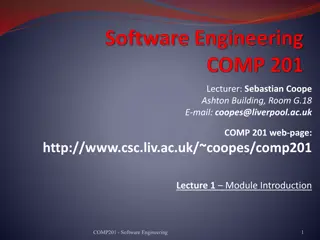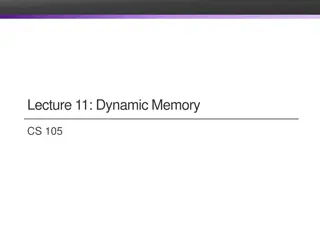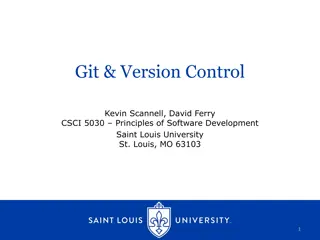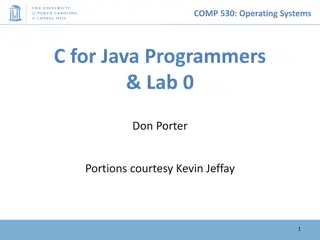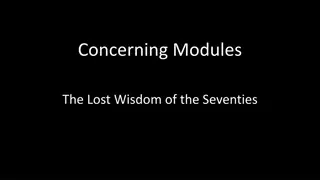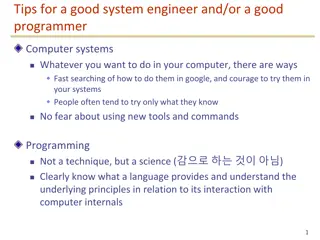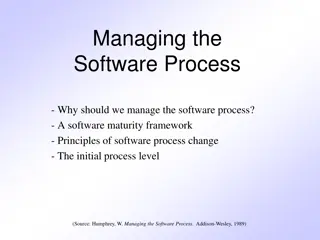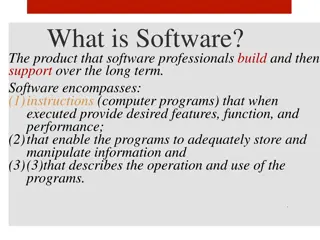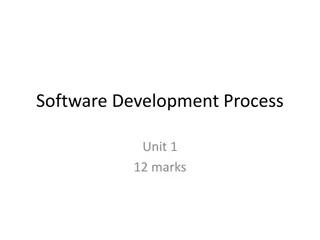Software Development Process for Programmers
Learn about the 7 major steps involved in writing programs, from problem analysis and program specification to design, implementation, debugging, testing, and maintenance. Get insights on how to approach software development systematically and effectively. Explore an example problem of converting temperatures from Celsius to Fahrenheit. Homework assignment reminder included.
Download Presentation

Please find below an Image/Link to download the presentation.
The content on the website is provided AS IS for your information and personal use only. It may not be sold, licensed, or shared on other websites without obtaining consent from the author.If you encounter any issues during the download, it is possible that the publisher has removed the file from their server.
You are allowed to download the files provided on this website for personal or commercial use, subject to the condition that they are used lawfully. All files are the property of their respective owners.
The content on the website is provided AS IS for your information and personal use only. It may not be sold, licensed, or shared on other websites without obtaining consent from the author.
E N D
Presentation Transcript
15-110: Principles of Computing Functions- Part II Lecture 4, September 11, 2018 Mohammad Hammoud Carnegie Mellon University in Qatar
Today Last Session: Functions- Part I Today s Session: Functions- Part II: The software development process The Python math library Announcement: Homework Assignment (HA) 01 is due on Thursday, Sep 13, 2018 by 10:00AM
The Software Development Process Writing programs requires a systematic approach to problem solving, which incorporates 7 major steps 1) Problem analysis, which involves studying deeply the problem at hand 2) Program specification, which involves deciding exactly what (NOT how ) your program will do What is the input? What is the output? What is the relationship between the input and the output? 3) Design, which involves writing an algorithm in pseudocode This is where the how of the program gets worked out
The Software Development Process Writing programs requires a systematic approach to problem solving, which incorporates 7 major steps 4) Implementation, which involves translating your pseudocode into code (e.g., using Python) 5) Debugging, which involves finding and fixing errors (or what are often referred to as bugs) in your program Bugs can be of two types, syntax and semantic (or logical) bugs 6) Testing, which involves trying your program with an extensive set of test cases so as to verify that it works correctly
The Software Development Process Writing programs requires a systematic approach to problem solving, which incorporates 7 major steps 7) Maintenance, which involves keeping your program up-to-date with technology and the evolving needs of your users Most programs are never really finished!
Example Problem: Write a program that translates temperatures from degrees Celsius to Fahrenheit Solution: 1) Problem Analysis: Pretty clear; some people do not understand temperatures in Celsius; there is a mathematical formula to convert Celsius to Fahrenheit 2) Program Specification: Input: temperature in degrees Celsius (say, C) Output: temperature in degrees Fahrenheit (say, F)
Example Solution: 2) Program Specification: Relationship between input and output: We can do some quick figuring, after which we will realize that 0 Celsius is equal to 32 Fahrenheit and 100 Celsius is equal to 212 Fahrenheit With this information, we can compute the ratio of Fahrenheit to Celsius; I.e., (212 32)/(100 - 0) = 9/5 The conversion formula will then have the form F = 9/5C + k Plugging in 0 and 32 for C and F, we can immediately see that k = 32 Thus, the final formula will be F = 9/5C + 32
Example Solution: 3) Design: Pseudocode: Input: C Calculate F as (9/5) * C + 32 Output: F
Example Solution: 4) Implementation: Python Code: def main(): celsius = eval(input("What is the Celsius temperature? ")) fahrenheit = 9/5 * celsius + 32 print("The temperature is", fahrenheit, "degrees Fahrenheit") main() Let us run, debug, and test this code together!
Using the Math Library Python provides many useful mathematical functions in a special math library that we can leverage in our programs A library is just a module that contains some useful definitions Let us illustrate the use of this math library via computing the roots of a quadratic equation with the form ??2+ ?? + ? = 0 Such an equation has two solutions: ? = ? ?2 4?? 2?
Using the Math Library: An Example #The following line will make the math library in Python available for us. import math def rootsQEq(): print("This program finds the real solutions to a quadratic.") print() a = eval(input("Enter the value of coefficient a: ")) b = eval(input("Enter the value of coefficient b: ")) c = eval(input("Enter the value of coefficient c: "))
Using the Math Library: An Example #To call a function from the math library, we can use the #dot operator as follows: s_root_val = math.sqrt(b*b - 4 * a * c) root1 = (-b + s_root_val)/(2*a) root2 = (-b - s_root_val)/(2*a) print() print("The solutions are: ", root1, root2) #Call the function rootsQEq() rootsQEq()
Using the Math Library: An Example One sample run: This program finds the real solutions to a quadratic. Enter the value of coefficient a: 3 Enter the value of coefficient b: 4 Enter the value of coefficient c: -2 The solutions are: 0.38742588672279316 -1.7207592200561266
Using the Math Library: An Example Another sample run: This program finds the real solutions to a quadratic. Enter the value of coefficient a: 1 Enter the value of coefficient b: 2 Enter the value of coefficient c: 3 Traceback (most recent call last): File "/Users/mhhammou/Desktop/CMU-Q/Courses/15- 110/Programs/Lecture4/RootsQE.py", line 22, in <module> rootsQEq() File "/Users/mhhammou/Desktop/CMU-Q/Courses/15- 110/Programs/Lecture4/RootsQE.py", line 14, in rootsQEq s_root_val = math.sqrt(b*b - 4 * a * c) ValueError: math domain error What is the problem?
Using the Math Library: An Example The problem is that ?2 4?? < 0 The sqrt function is unable to compute the square root of a negative number Next week, we will learn some tools that allow us to fix this problem In general, if your program requires a common mathematical function, the math library is the first place to look at
Some Functions in the Math Library Python Mathematics ? English pi An approximation of pi e e ? An approximation of e sqrt(x) The square root of x sin(x) sin x The sine of x cos(x) cos x The cosine of x tan(x) tan x The tangent of x asin(x) acos(x) arcsin x arccos x The inverse of sin x The inverse of cos x atan(x) arctan x The inverse of tangent x
Some Functions in the Math Library Python Mathematics English log(x) ln x The natural (base e) logarithm of x log10(x) Log10 x The common (base 10) logarithm of x The exponential of x Ex ? ? exp(x) ceil(x) The smallest whole number >= x floor(x) The largest whole number <= x
Summary Programmers use functions to reducecode duplication and structure (or modularize) programs The basic idea of a function is to write a sequence of statements that together can achieve a certain specification and give that sequence a name Once a function is defined, it can be called over and over again Parameters allow functions to receive different input values
Summary The scope of a variable is the area of the program where it may be referenced Formal parameters and other variables (which are not labeled as global) inside a function are local to the function (i.e., can be accessed only within that function) Local variables are distinct from variables of the same name that may be defined elsewhere in the program
Summary A function can communicate information back to a caller through returning a value (or multiple values more on this later) Python passes parameters by value Writing programs requires a systematic approach to problem solving, which involves analysis, specification, design, implementation, testing, debugging, and maintenance
Summary Python programmers can use common mathematical functions defined in the math library To use any of these functions, you must first import the math library in your program
Next Lecture Decision Structures- Part I




